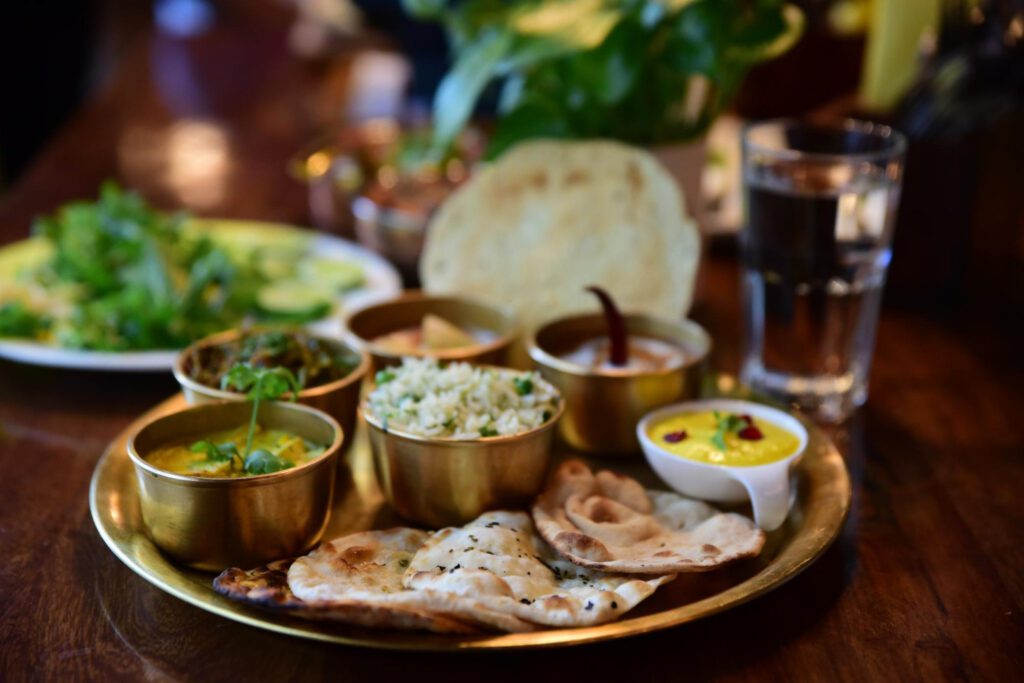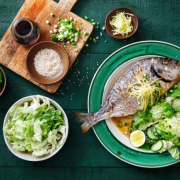Tradition of Thalis

Indian vegetarian Thalis, affectionately referred to as Veg Meals in South India, hold a special place in every Indian’s heart. Through a diverse collection of tastes and textures, these traditional meal platters offer diners a burst of flavours in every bite. But is there a recipe for a perfectly balanced vegetarian Thali? To know more, we must look at this beloved Indian preparation’s origin story.
Some believe that the roots of the Great Indian Thali lie in the ayurvedic Six Taste Theory, which focuses on meals that strike a balance between the doshas for proper regulation of nutrition and digestion. However, in it’s most recent history, the majestic Indian vegetarian Thali has a more royal lineage. Once a favourite of India’s maharajas, thalis have long been a symbol of oppulence! Today however, Thalis have a deeper, heartier meaning to all those that relish them, as a wholesome and nutritious meal for all to enjoy!
Elements of a lip-smacking Thali
1. Going with the Grain
At the heart of every thali, lies the grains that build the foundation of the dish. Traditional Thalis usually include a combination of rice and bread – generally rotis, chapattis, or parathas. Some regional variations often include jowar or bajra rotis, depending on their availability.
2. Peak Protein
A standard Indian Vegetarian Thali also includes a gravy made using lentil, legumes, or beans, which are all excellent sources of plant-based protein. In addition to being rich and flavourful, these dishes are also extremely nutritious and packed with goodness.
Some favourites include Dal Makhani, Sambar, Palak Dal, Rajma, and more!
3. Vegetable Delight
A vegetarian Thali would be incomplete without the star of the show, the vegetable itself! Commonly known as a sabzi or poriyal, the vegetable side dishes that create a truly balanced thali can be served cooked, raw, or slightly pickled to enhance the flavour and nutritional profiles of the Thali
4. Dare to dairy!
Indian Vegetarian Thalis, across the board usually feature some form of dairy either as paneer of yogurt, to add to the creaminess of the preparations. While most prefer to serve yogurt in its original form, in coastal areas and parts of Southern India, it is often used to make gravies that combat the heat and cool down the body.
5. Curate Accompaniments
Traditional Indian vegetarian Thalis also feature a selection of accompaniments such as Chutneys, pickles, and raita that act as delicious sides that complement the main dishes, adding tanginess and contrasting tastes.
5. Ending on a Sweet Note
Most traditional Thalis often include a sweet dish or dessert right at the end to really tie the meal together. Usual favourites include payasam, gulab jamun, kheer, or halwa.
A Taste of Diversity
The beauty of the vegetarian thali lies in its adaptability to diverse regional cuisines. From the South Indian Sadhya featuring dishes like sambar and aviyal, to the North Indian Rajasthani thali highlighting dal baati churma, each region brings its own unique flavors and traditions to the thali concept.
Also Read: The Rise of Vegan Indian Cuisine: Plant-Based Delights to Try
Conclusion
The Indian vegetarian Thali is a celebration of the diverse flavors, culture, and traditions of Indian cuisine, encapsulating the wholesome and nutrient-rich essence of a plant-based diet. The symphony of spices created by the harmonious blend of dishes that range from tangy to sweet, mild to fiery, and simple to elaborate, that the perfect thali offers is a culinary experience that is both fulfilling and unforgettable. Whether enjoyed at home or savored at a traditional Indian restaurant, the vegetarian thali invites individuals to explore the rich tapestry of India’s heritage of flavours, textures, and culture.

















[…] Also Read- 6 Elements of the Perfect Indian Vegetarian Thali […]
[…] Braised Tofu with Mushrooms: A vegetarian delight that showcases the flavors of silky tofu and fragrant […]